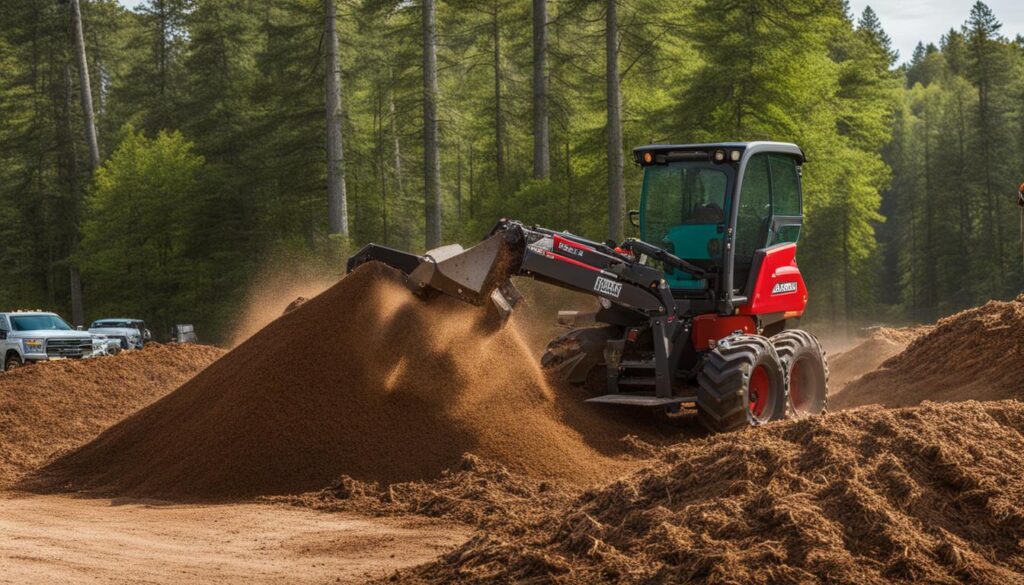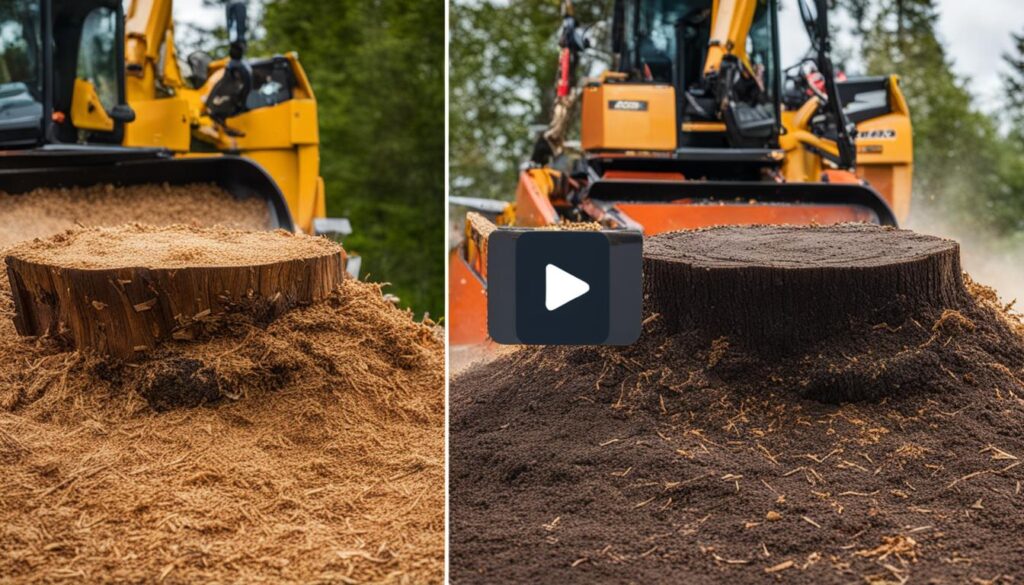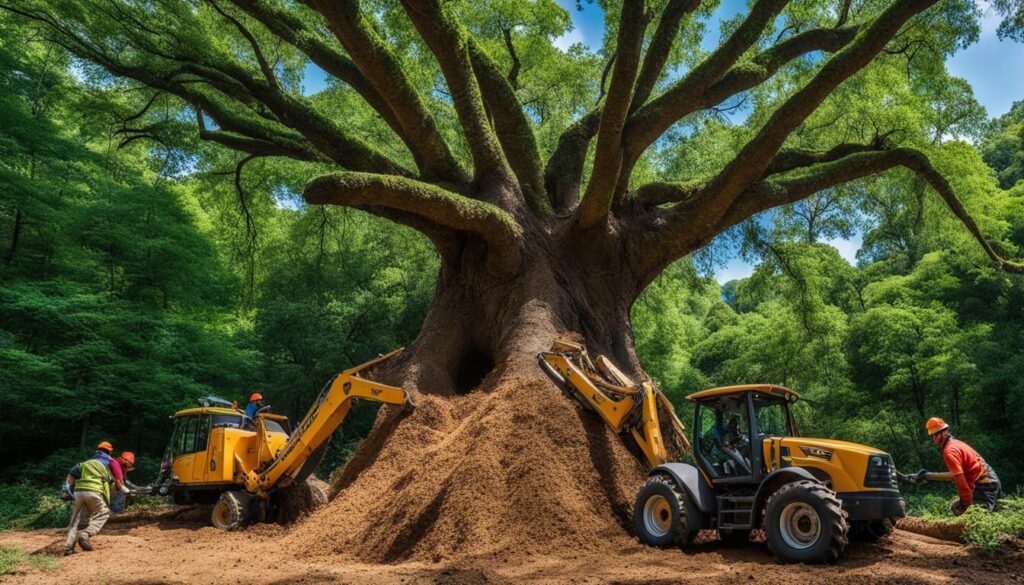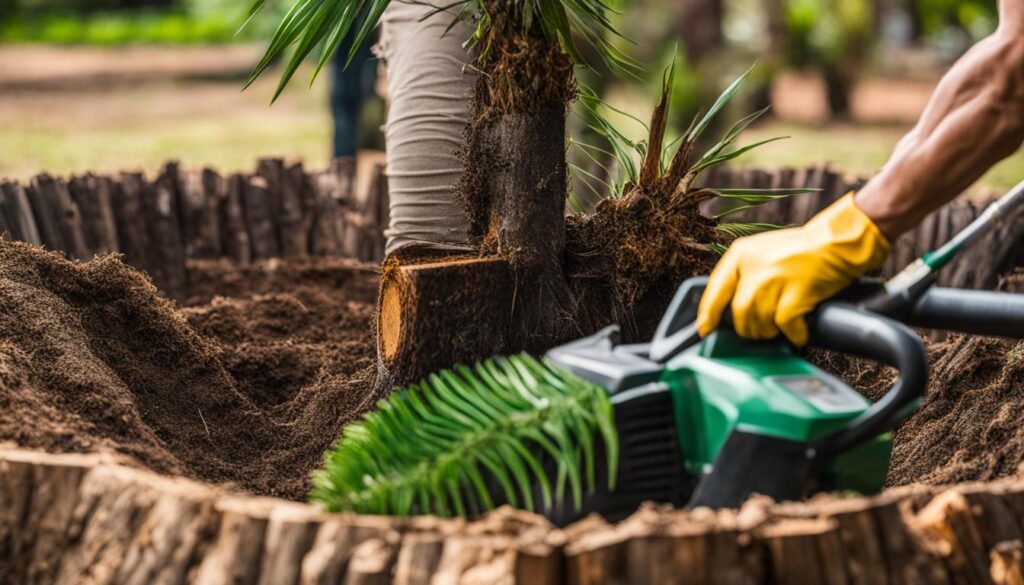As a homeowner who’s recently had a tree cut down, I find myself in the common predicament of what to do with the remaining stump. The presence of tree stumps can turn your beautifully manicured lawn into an unsightly expanse. When considering your options, you may encounter the debate of stump grinding vs removal. Undoubtedly, each has its advantages and disadvantages relative to cost, aesthetic impact, and the future use of your land. I’ve learned that stump grinding serves as a less invasive method where the stump is mulched down, leaving roots to decay. While this may pose issues for replanting due to lengthy decay times, it’s gentler on the wallet and landscape. On the other end, stump removal involves pulling out the stump and roots, facilitating replanting and eliminating concerns related to pest harborage. However, this method comes with a heftier price tag and a substantial ground cavity. With the services available today—stump grinding service and stump removal service—it’s vital to discern the differences between stump grinding and removal to make an educated decision that aligns with your property goals.
Key Takeaways
- Stump grinding and stump removal each offer distinct benefits and drawbacks suited for different landscaping goals.
- Stump grinding is a less costly alternative that minimizes landscape disturbance, with the trade-off of restricting certain future planting endeavors.
- Stump removal, although more expensive, allows for complete extraction and a clean slate for new projects and replanting.
- Consider the long-term impact on your yard, potential for pest problems, and budget when choosing between stump grinding and removal.
- Understanding the root systems and overall lawn aesthetics is crucial when making a decision that affects your home’s outdoor environment.
Understanding Stump Grinding vs Removal
When it comes to reshaping the post-arboreal landscape of my garden, I recognize the essential differences between stump grinding and stump removal. Each method has its unique benefits and impact on the yard. As a professional in the field, I’m here to guide you through these options.
The Basics of Stump Grinding
The benefits of stump grinding are immediately apparent to any homeowner who has been through the process. This method involves a specialized piece of equipment known as a stump grinder which shreds the wood into chips. From a professional’s standpoint, tree stump grinding is a preferred solution for clients looking for efficiency and minimal disruption to their landscaping. The stump grinding process leaves the roots beneath the surface, where they naturally decay over time without the immediate need for excavation.
What Does Stump Removal Entail?
In contrast to grinding, the stump removal process is more comprehensive — it involves not just eradicating the visible stump but also its root system. As a professional stump grinding and removal specialist, I’ve seen stump removal provide a total clearance that can be ideal for clients looking to have a clean canvas for landscaping endeavors. However, it’s important to consider that this method creates a significant void in the ground and may disturb the surrounding vegetation and soil.
Comparing Methods: Impact on Your Yard
When discussing the benefits of stump removal with clients, I emphasize the long-term impact on their landscape. While grinding is a quick fix, removal ensures that the old tree’s legacy will not interfere with future planting or construction plans. Yet, there’s no denying that professional stump grinding offers a quick and generally more cost-effective way to deal with a tree’s remains, which can be particularly attractive for those on a budget or selling their property.
Benefits of Stump Grinding
As a homeowner, I’m always looking for ways to maintain my landscape efficiently while keeping costs down. Whenever it’s time to decide what to do with a leftover tree stump, I consider the stump grinding cost and the advantages it brings. In my experience, stump grinding has consistently proven to be an economically sound decision. Let me take you through a few reasons why choosing stump grinding can benefit you and your garden.
Cost-Effectiveness of Stump Grinding
Many of us are conscientiously keeping track of our spending, and when it comes to landscaping needs, the cost comparison stump grinding vs removal shows a clear preference for grinding. Grinding a stump is typically less expensive than removal because it requires less labor, time, and machinery. When I had to deal with tree stumps in the past, the reduced cost of stump grinding was a decisive factor, allowing me to allocate funds to other home improvement projects.
Minimizing Landscape Disruption
One significant reason for choosing stump grinding over removal is the minimal disruption it causes to the rest of my yard. Unlike stump removal, the grinding process doesn’t leave a gaping hole or disturb the existing landscape, which means less work for me in terms of yard repair and maintenance. The mulch produced from grinding has been particularly useful in my flower beds and around trees, offering a beneficial by-product instead of excess waste.
Speed and Efficiency of the Grinding Process
The grinding process is fast and efficient, swiftly turning a cumbersome stump into useful mulch. This rapid approach to dealing with tree stumps aligns well with my schedule, especially when I want to quickly improve the appearance of my landscape without investing too much time. While there are advantages of stump removal, the immediacy of stump grinding is appealing for its efficiency alone.
Advantages of Complete Stump Removal
As I delve into the realm of landscaping and yard care, I’m continually confronted with decisions about the aesthetics and health of my outdoor space. One such decision is whether to opt for stump removal. Factoring in stump removal cost and the potential need for a professional service tree stump removal near me, complete stump removal offers numerous advantages that make it a compelling choice for many homeowners.
Opportunity for Landscape Alteration
The freedom to reimagine and modify the landscape is a significant benefit of stump removal. Without the presence of a stubborn stump, I have the luxury of planning extensive garden renovations, complete with new plantings and grading adjustments. It’s a game-changer for anyone looking to enhance their outdoor living space.


Long-Term Solutions to Tree Stump Issues
Opting for full stump removal rather than a temporary workaround addresses tree stump issues for the long haul. It ensures that no root structures will impede future gardening or landscaping projects, a realization of the full advantages of stump removal. It’s about reclaiming my property and using the space to its full potential, unrestricted by the remnants of former greenery.
Elimination of Possible Pests and Fungi
By removing the stump, I also safeguard my property against the silent threat of pests and fungi that thrive on decaying wood. The eradication of these unwanted stump remnants precludes invasions of termites, carpenter ants, and wood-decaying fungi, which could otherwise extend to healthy vegetation or even structures on my property. It’s peace of mind that simply grinding the stump cannot provide.
In the end, when to choose stump removal depends largely on my long-term vision for my outdoor space and the desire to maintain a healthy, pest-free environment. The decision is nuanced, dependent on several personal and property considerations, but the clear-cut advantages of a complete removal provide a strong case for those looking to invest in their property’s future.
Potential Drawbacks of Stump Grinding
As someone who explores various gardening and landscaping services, I’ve come to understand that while stump grinding near me might be a popular and often efficient choice for dealing with the remnants of a felled tree, it isn’t without its trade-offs. Let’s delve into what homeowners might expect following the completion of stump grinding, including the immediate and long-term impacts on their yard.
What Gets Left Behind After Stump Grinding?
In my experience, one of the primary reasons for choosing stump grinding is to alleviate the impact on the surrounding landscape. Yet, the process does not remove the entirety of the stump and its root system. The ground-down roots, left to decompose, can take significant time to break down, which could be crucial for those planning to make immediate use of the space.
Aesthetic and Replanting Limitations
From an aesthetic consideration when pondering stump grinding, there’s much to think about. The centerpiece of a well-manicured lawn can turn into a non-feature once ground. For my yard’s appeal, this is where I weigh the visual balance following the service. Moreover, should I wish to plant a new tree in the same spot, there’s hesitation; the residual roots can restrict growth and nutrient availability for the new tree.
Cleanup Considerations and Efforts
Post-stump grinding, the cleanup can often be an underrated consideration. Although some might view the resulting wood chips as beneficial mulch, dispersing them evenly or removing them entirely often falls on the homeowner’s shoulders. On my end, I’ve found filling the left-behind depression with topsoil and seeding it for grass growth necessary for consistent lawn aesthetics; an additional step many might not anticipate initially.
Understanding these potential drawbacks of stump grinding, from lingering roots to the extra labor of clean-up, offers a comprehensive perspective. While it’s generally quicker and more cost-efficient than full removal, it’s essential to assess the long-term goals for your landscape before settling on this method.
Challenges of Stump Removal
As someone who takes pride in maintaining a pristine landscape, I’ve faced the daunting task of tree stump removal. Unlike its lesser cousin, stump grinding, the full stump removal process requires a considerable amount of manual labor and precision. In my experience, the cost of manual tree stump removal can be surprisingly steep due to the sheer amount of work involved.
One of the core stump removal challenges is the necessity for heavy-duty machinery. This equipment must not only be rented or hired, but also operated by someone with specialized skills, further adding to the expense. The process is labor-intensive, involving digging around the stump, cutting through the roots, and the physical lifting of the often large and unwieldy stump out of the ground.
The disruption to the surrounding landscape is another concern; stump removal service professionals must navigate the delicate balance of extracting the stump without causing undue harm to the existing flora and fauna. Post-removal, soil restoration becomes a significant aspect of the job, ensuring that the ecosystem remains as undisturbed as possible and is ready for whatever new planting plans await.
When to Choose Stump Grinding Over Removal
As I navigate the various aspects of tree management, I often find myself weighing the merits of stump grinding against full removal. Understanding the circumstances where stump grinding prevails as the smarter choice can significantly affect both the aesthetics and functionality of my landscaping projects. My decision typically hinges on several key factors, including the urgency of the project, budgetary constraints, and long-term landscape plans.
Situations Favoring Stump Grinding
One of the major reasons for choosing stump grinding is when immediate site clearing isn’t a top priority, and I want to avoid the large void that comes with stump removal. If the tree stump is not centrally located or doesn’t interfere with new construction, then grinding offers a less invasive option. Moreover, it’s an excellent alternative if I’m dealing with a tight budget. The cost comparison stump grinding vs removal typically shows that grinding is the more cost-effective service, saving me money that can be allocated to other areas of my garden or home maintenance.
Assessing Landscape Goals and Budget
My landscape goals are a decisive factor when choosing between stump grinding and removal. If my intention is to repurpose the area immediately for replanting or for installing outdoor features, I might lean towards complete stump removal despite its higher cost and larger impact on the landscape. However, if beautifying the space without drastic changes is the objective, I find that stump grinding sufficiently enhances the appearance. Considering both the advantages of stump removal and the affordability of grinding, it’s crucial that I take the time to analyze my long-term vision for the space before opting for one over the other.
Deciding Based on Time Constraints
Time is often of the essence in my projects, and I need solutions that don’t hinder progress. When I need a quick turnaround, stump grinding is the clear winner. This method is not only expedient but also mitigates the extent of soil disturbance. The speedy process allows me to move on to other phases of my project without significant downtime. Ultimately, grappling with when to choose stump grinding comes down to a balanced assessment of how it aligns with my immediate needs and future plans for the outdoor area.


When Stump Removal is the Ideal Choice
As I delve deeper into my landscaping journey, I’m frequently faced with decisions that will shape the future of my outdoor space. It’s become clear to me that for significant undertakings, including full-scale garden transformations or the introduction of new plants, the benefits of stump removal often outweigh other options. Utilizing a professional stump removal service becomes imperative when I’m envisaging a yard without the constraints imposed by leftover tree root systems.
Sequential Planning for Your Yard
Thoughtful planning is critical when undergoing landscape redesign. My experience tells me that tree stump removal sets a clear stage for any upcoming projects, from structural garden modifications to aesthetic enhancements. It’s a process that affords me the freedom to reimagine and execute my vision without the nuisance of obstructions lurking beneath the soil’s surface.
Addressing Extensive Root Systems
Addressing tree root systems is a part of any comprehensive stump removal strategy. In cases where I’ve encountered sprawling roots, the decision to employ tree stump removal near me was straightforward. The reasoning is simple: the removal of these pervasive underground networks ensures that future landscaping plans remain unhampered, allowing for an unhindered, fresh start to my gardening endeavors.
Regulations and Permit Considerations
My mindfulness of regulations and permits has steered many of my landscaping decisions. It’s essential to acknowledge that local guidelines may mandate complete tree and stump extraction. In my quest to abide by these regulations, I’ve come to appreciate the importance of professional stump removal services in keeping my projects compliant and on schedule, thereby sidestepping potential legal entanglements.
Factors Influencing Stump Grinding Service Costs
When I embark on the task of clearing my yard of tree stumps, understanding the nuances of stump grinding costs becomes essential. It’s not a flat-rate service; several elements contribute to the pricing, ensuring that I make an informed decision tailored to my property’s needs.
Size and Accessibility of Tree Stump
The size of the tree stump is a primary determinant of the cost. Larger stumps require more time and power to grind down, which translates to higher expenses. Accessibility is equally critical; if the stump is nestled between closely planted shrubs or is located in a hard-to-reach spot, the complexity of the job increases, influencing the stump grinding cost.
Local Market Rates and Service Variations
Stump grinding service cost factors are heavily influenced by regional market rates, which fluctuate based on demand and competition. In addition, the service scope can vary; some providers might offer inclusive packages that cover cleanup and debris disposal, while others may charge extra for these services. It’s important for me to explore the “stump grinding near me” options to compare and contrast what’s included in the cost.
Calculating the Cost-Benefit Ratio
Prior to selecting a service, I examine the cost-benefit ratio. This involves weighing the upfront cost against the long-term advantages and potential savings. Though tree stump grinding can seem like an additional expense in the short term, it helps me avoid future issues such as pests and property damage, proving economically sensible in the long run.
How Stump Removal Cost is Determined
When I’m faced with the task of removing an unsightly tree stump from my yard, understanding the factors that impact the overall stump removal cost is essential. It’s not just about a flat fee; several dynamic elements play a crucial role in shaping the final price.
Assessment of Required Labor and Machinery
The first thing that contributes to the cost is the labor involved. Given that professional stump removal requires both skilled personnel and the rental or use of heavy-duty machinery, such as stump grinders or excavators, these expenses quickly add up. The size and scope of the job will dictate the type of equipment needed and the time it will take, both of which are reflected in the quote I receive from local services. Seeking a “stump removal near me” often leads to competitive pricing and personalized service estimates based on my specific needs.
Examination of Stump Characteristics and Surroundings
The characteristics of the tree stump itself—the wood density, diameter, and root system complexity—significantly shape the extraction process. Moreover, the stump’s surrounding environment, including access limitations and the proximity to other valuable plants or structures, can complicate removal efforts. These considerations are meticulously evaluated by the professionals to ensure a safe and efficient removal process, which is factored into the tree stump removal costs.
Disposal Fees and Land Restoration Costs
Finally, the disposal of the stump and roots contributes to the cost. Whether it’s through chipping, hauling away, or incineration, different methods come with varying price tags. Additionally, once a stump is removed, restoring the landscape to its original condition or preparing it for new plantings can also incur costs. This might include soil filling and leveling, seeding, or even sodding, all of which are important to consider when budgeting for tree stump removal costs.
In sum, comprehending these factors ensures I am well-prepared to budget for a stump removal project without any surprises.
Environmental Considerations in Stump Grinding vs Removal
When it comes to addressing the remnants of tree stumps in our landscapes, both stump grinding and removal hold significant environmental implications that I consider with much care. My goal is always to balance aesthetic desires and practicality with stewardship for our surrounding ecosystem. The environmental impact of stump grinding vs removal is a complex issue involving soil preservation, the local biosphere, and our responsibility toward the conscientious handling of removed material.
Assessing the Eco-Friendly Aspects of Each Method
In choosing between stump grinding and full stump removal, I probe the eco-friendly merits inherent in each. Stump grinding tends to be less invasive, leaving the soil structure predominantly intact and reducing the risk of disrupting underground habitats. However, the decay of remaining roots must be contemplated – a process that might take years and potentially hinder soil quality. On the other hand, complete stump removal eliminates long-term decay but at the expense of immediate, significant soil disturbance. As an advocate for eco-friendly stump removal, my approach always prioritizes minimal environmental disruption while achieving the project’s objectives.
Chemical Usage in Stump Removal and Its Alternatives
Chemical stump removal presents another dimension to consider, one that could result in residual impact on soil health and local fauna. My stance veers away from applying harsh chemicals that permeate the soil, instead, I explore alternative methods that align with responsible environmental practices. Whether it’s mechanical means or natural decomposition accelerants, such options typically align better with eco-friendly aspirations and ensure the preservation of the immediate ecology.
Responsible Disposal of Tree Stump Material
Once a stump is ground down or completely removed, the question of responsible tree stump disposal surfaces. Rather than viewing the by-products as waste, I recognize them as valuable organic material that can be repurposed, whether as mulch for gardens or as biomass for energy production. By transforming what remains into a resource, I not only minimize landfill contributions but also close the loop in a cycle of sustainability that benefits our environment and community alike.
FAQ
What is stump grinding and how does it work?
Stump grinding is a method for dealing with tree stumps by using a stump grinder, a high-speed cutting tool with carbide-tipped teeth that grinds the stump into small chips. This process shreds the stump down below ground level, leaving the roots to decay over time and minimizing landscape disturbance.
What entails stump removal, and how does it differ from stump grinding?
Stump removal involves physically digging out the tree stump and removing all associated roots. It is more intrusive than stump grinding, requiring heavy machinery to completely extract the stump and roots. This method leaves a large hole in the ground and typically costs more, but it completely clears the area for new landscaping projects.
What are the main differences between stump grinding and stump removal?
The primary differences lie in the techniques and outcomes. Stump grinding is less invasive, cost-effective, quick, and leaves roots to decay, while stump removal is more comprehensive, allowing for immediate replanting but is more labor-intensive, costly, and leaves a significant hole to fill.
Why might stump grinding be a more suitable option for some homeowners?
Stump grinding is often favored for its cost-effectiveness, minimal landscape disruption, and quick turnaround. This makes it an ideal choice for homeowners who are looking for a straightforward solution to eliminate the visual nuisance of a stump without extensive yard alteration plans.
When is complete stump removal recommended over stump grinding?
Complete stump removal is recommended when homeowners plan to undertake major landscaping revisions, need to plant new trees in the exact location, or must address extensive root systems that could interfere with other plants, structures, or underground utilities.
What considerations need to be taken into account when cleaning up after stump grinding?
Cleanup after stump grinding involves removing the resultant wood chips or using them as mulch, filling the hole with soil, and potentially reseeding the area. Additionally, homeowners must consider that the decaying roots left behind might cause ground settling, which may require further attention over time.
What challenges does stump removal present?
Stump removal can be laborious and time-consuming, often requiring the use of heavy equipment. It can also disrupt the surrounding landscape and ecosystem. There are logistical considerations such as how to dispose of the large root ball and the additional costs of land restoration post-removal.
How do time constraints influence the choice between stump grinding and stump removal?
If immediate results are needed, stump grinding is usually the faster option, as it requires less labor and machinery. Stump removal, on the other hand, may take longer due to its comprehensive nature, including excavation and the handling of larger, heavy pieces of wood.
How is the cost of stump grinding services calculated?
The cost of stump grinding services is influenced by the size and accessibility of the stump, the local market rates, the service provider’s offerings, and if additional services such as cleanup or topsoil filling are part of the package. Homeowners should weigh these factors against desired results and potential long-term considerations.
What factors affect the cost of stump removal services?
The cost of stump removal services depends on the complexity of the job, including the size and hardness of the stump, the necessary labor and machinery, the surroundings, and proximity to utilities. Furthermore, costs may be affected by disposal fees and restoration work needed to return the landscape to its desired state.
How do environmental considerations impact stump grinding and stump removal?
Environmental considerations include the preservation of soil structure, prevention of ecosystem disturbance, and the method of disposal for the removed stump material. While stump grinding and mechanical removal typically avoid chemicals, they still necessitate careful planning to minimize environmental impact.



